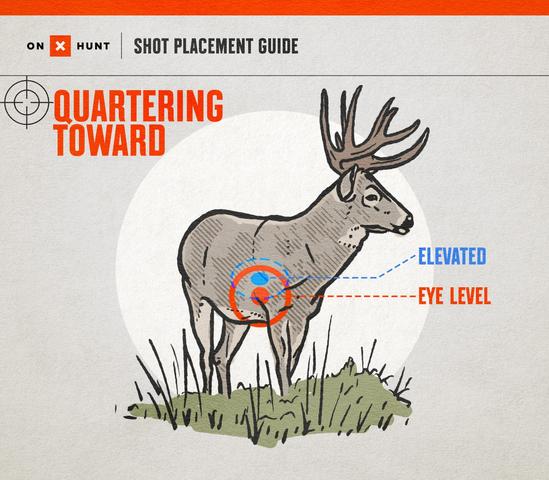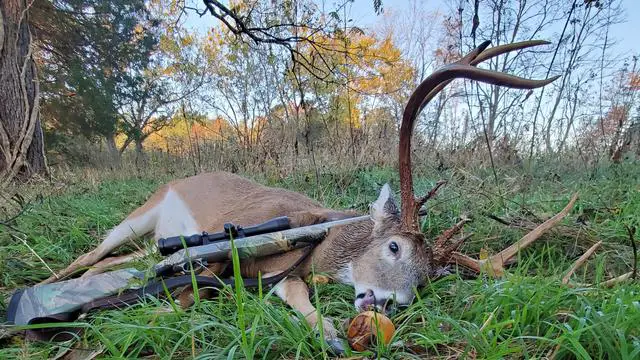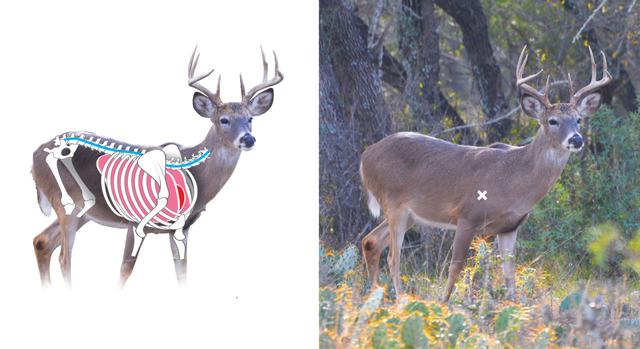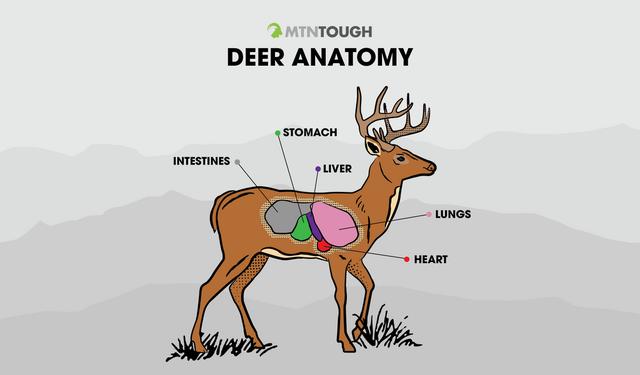“Mastering the art of dropping a deer with your first shot is an essential skill for any aspiring hunter. In this guide, we uncover foolproof techniques and expert tips to guarantee your success in bringing down a deer swiftly and efficiently. From selecting the right ammunition to honing your shooting skills, embark on a journey towards becoming a skilled marksman and increase your chances of securing that elusive first-shot success.”
Mastering the Art of Dropping a Deer with Your First Shot

When it comes to hunting deer, sometimes it’s necessary to make sure the deer goes down immediately with your first shot. This can be crucial in situations where the deer is close to leaving your hunting area or if there are factors that could complicate the recovery process. In these cases, it’s important to know how to effectively drop a deer in its tracks.
One method for achieving an instant kill is by using a gun. The energy released by a rotating bullet or slug creates hydrostatic shock, significantly increasing the chances of a quick and clean kill. Unlike with bowhunting, where an arrow is meant to stop oxygen delivery to vital organs over time, a well-placed shot from a gun can instantly incapacitate a deer.
To ensure an effective shot, it’s important to aim for the central nervous system. However, aiming for the brain or rump is not recommended as these areas are not ideal targets. Instead, aim for the shoulder area, specifically through the near-side shoulder and into (or through) the off-side shoulder. This will not only damage the central nervous system but also take out the upper lung area and forelegs.
While some argue that hitting both shoulders may result in wasted meat, with proper bullet or slug construction, fragmentation and meat loss can be minimized. It’s important to prioritize killing the deer cleanly and quickly rather than risking losing it altogether.
It’s worth noting that not all shots will result in dropping a deer on the spot. If you hit just below or on the fringe of the shoulder blades, there might not be enough skeletal damage to immediately immobilize the deer. However, lung devastation should still cause death within seconds.
Choosing an appropriate firearm cartridge is also essential in achieving knockdown power on whitetails. Various cartridges such as.280 Rem., 7mm Rem. Mag., and 6.5 Creedmoor have proven to be effective in dropping deer with a well-placed shot.
To minimize the risk of losing a deer, it’s advisable to avoid hunting right on the edge of your property. Foster good relationships with neighboring landowners and establish agreements for deer recovery. Additionally, be mindful of hunting in habitats that make tracking and recovery difficult, such as swamps.
Lastly, pay attention to weather conditions that could affect blood trail visibility. If shooting conditions are riskier due to factors like rain or snow, it becomes even more important to ensure an instant kill.
Mastering the art of dropping a deer with your first shot requires skill, knowledge of anatomy, and proper firearm selection. By aiming for the central nervous system and using appropriate ammunition, you can increase your chances of achieving an instant kill and minimizing the risk of losing a deer.
Ensuring a Clean and Quick Kill: Tips for Dropping a Deer Instantly

When hunting deer, there are situations where you may need to drop the deer instantly to ensure a clean and quick kill. Here are some tips to help you achieve this:
1. Aim for the Vital Organs
To ensure an instant kill, it is important to aim for the vital organs of the deer. The best shot placement is neither at the brain nor at the rump. Instead, aim for the central nervous system, which lies between these two areas. By hitting this area, you increase your chances of dropping the deer instantly.
2. Consider Shooting Through Both Shoulders
Shooting through both shoulders of the deer can also lead to an instant kill. This requires accurate shot placement and using a high-quality bullet or slug that can penetrate through both sides of the deer’s body. By damaging both shoulders and potentially snapping the spinal cord, you can effectively immobilize the deer.
3. Avoid Head and Neck Shots
While head and neck shots may seem like they would result in an instant kill, they are not always reliable and can lead to severe injuries without immediate death. Shattering lower jaws or blowing off noses is inexcusable and should be avoided. It is best to focus on targeting vital organs or shooting through both shoulders for a cleaner and quicker kill.
4. Use High-Quality Ammunition
Using high-quality ammunition is crucial when aiming for an instant kill. Quality bullets or slugs are designed to deliver maximum energy upon impact, increasing your chances of dropping the deer instantly. Make sure to choose ammunition that is appropriate for your firearm and hunting conditions.
5. Minimize Risk of Losing Deer
To minimize the risk of losing a shot deer, it is important to foster good relationships with neighboring landowners. Seek permission before the hunt to enter their property for deer recovery if necessary. Additionally, avoid hunting too close to property edges where legal access might be restricted. Good communication with neighbors can help ensure a smoother recovery process.
By following these tips, you can increase your chances of dropping a deer instantly and ensuring a clean and quick kill. Remember to always prioritize ethical hunting practices and strive for humane kills.
The Ultimate Guide to Guaranteeing a One-Shot Kill on Deer

1. Choose the Right Firearm and Ammunition
– Select a firearm that you are comfortable and proficient with, ensuring accuracy in your shots.
– Use high-quality ammunition specifically designed for hunting deer, such as expanding bullets or slugs.
– Consider the caliber or gauge of your firearm, as different options offer varying levels of knockdown power.
2. Aim for Vital Organs
– The most effective shot placement is behind the shoulder, targeting the heart and lungs.
– Avoid aiming for the head or neck, as these areas are smaller targets and can result in non-lethal wounds.
– Hitting vital organs ensures a quick and humane kill, minimizing suffering for the deer.
3. Consider Shot Placement for Instant Knockdown
– To maximize knockdown power, aim slightly high in the shoulder area.
– This shot placement will not only damage vital organs but also snap the spinal cord, immobilizing the deer instantly.
– Shooting through both shoulders can also increase knockdown power by causing severe damage to the front legs.
4. Minimize Risk of Losing Deer
– Avoid hunting near property boundaries where permission to retrieve a deer might be denied.
– Foster good relationships with neighboring landowners to secure access for game recovery if necessary.
– Stay away from habitats that pose challenges for tracking wounded deer, such as swamps or dense vegetation.
5. Be Mindful of Environmental Factors
– Consider weather conditions that may affect tracking efforts, such as heavy rain or snowfall.
– If hunting near water bodies, be prepared to track using alternative signs like broken vegetation or disturbed sediment if blood trails wash away.
By following these guidelines and practicing ethical hunting techniques, you can increase your chances of achieving a one-shot kill on deer while minimizing the risk of losing a wounded animal. Remember to prioritize clean and humane kills, ensuring that your hunting experience is both successful and responsible.
Proven Techniques for Dropping a Deer in Its Tracks with Precision

1. Aim for the Shoulder
One of the most effective ways to drop a deer instantly is by aiming for the shoulder. By shooting through the near-side shoulder and into (or through) the off-side shoulder, you can hit vital organs while also damaging the central nervous system. This combination of impact can result in an immediate kill, preventing the deer from running off and making recovery difficult.
2. Use High-Quality Ammunition
Choosing the right ammunition is crucial when it comes to dropping a deer in its tracks. Opt for high-quality bullets or slugs that are designed for maximum energy transfer and terminal performance. These projectiles should stay intact and deliver hydrostatic shock upon impact, increasing your chances of an instant kill.
3. Practice Shot Placement
Shot placement is key to achieving an instant kill. Take the time to practice your aim and shot placement before heading out into the field. Aim for the vitals, such as the heart and lungs, to ensure a quick and humane kill. Avoid risky shots that may only wound the deer or result in unnecessary suffering.
4. Consider Distance and Conditions
Take into account factors such as distance and environmental conditions when deciding whether to take a shot. Longer distances may increase the chance of error, while adverse weather conditions or terrain features like swamps can complicate tracking if the deer runs off after being shot. Assess these variables before taking a shot to minimize the risk of losing a wounded deer.
5. Build Good Relationships with Neighbors
To avoid potential conflicts over retrieving shot deer on neighboring properties, foster good relationships with your neighbors beforehand. Seek their permission to enter their land if necessary, especially if there’s a chance that a wounded deer may cross the boundary. Establishing these agreements in advance can save you from legal complications and ensure a smoother recovery process.
6. Be Prepared for Follow-Up Shots
Even with precise shot placement, there’s always a chance that a deer may not drop instantly. Be prepared for follow-up shots if necessary, but only take them if it’s safe to do so and you have a clear shot. Practice shooting under realistic hunting scenarios to improve your accuracy and increase your chances of making an effective follow-up shot if needed.
Remember, ethical hunting practices prioritize clean and humane kills. While the goal is to drop a deer in its tracks when necessary, it’s important to prioritize shot placement and use appropriate ammunition to minimize suffering and ensure quick recoveries.
Maximizing Your Chances of Dropping a Deer with the First Shot

1. Aim for the vital organs
When using a gun, it’s important to aim for the vital organs to increase your chances of dropping the deer with the first shot. The best aiming points are neither the brain nor the rump, as these can result in a loss of the shot deer. Instead, aim for the lower shoulder area, shooting through the near-side shoulder and into (or through) the off-side shoulder. This will ensure that you hit both shoulders and potentially snap the spinal cord while taking out the upper lung area.
2. Use quality ammunition
Using good quality ammunition is crucial in maximizing your chances of dropping a deer with one shot. Quality bullets or slugs are designed to deliver hydrostatic shock upon impact, significantly increasing your chances of an instant kill. Make sure to choose ammunition that is appropriate for your firearm and hunting conditions.
3. Practice precise shot placement
Developing accurate shooting skills and practicing precise shot placement can greatly improve your chances of dropping a deer with one shot. Take time to familiarize yourself with your firearm and its capabilities, as well as practice shooting from various positions and distances. By hitting specific target areas consistently, such as the lower shoulder or upper lung area, you can increase your chances of an immediate kill.
4. Consider environmental factors
Take into account environmental factors that may affect your ability to drop a deer with one shot. If you’re hunting near swamps or bodies of water where blood trails may be difficult to follow, it’s essential to ensure that you can find and recover the deer without relying solely on blood sign. Additionally, consider weather conditions such as heavy rain or snowfall that may complicate tracking efforts.
5. Foster good relationships with neighboring landowners
To minimize the risk of losing a shot deer, foster good relationships with neighboring landowners. Before the hunting season begins, discuss and establish agreements regarding deer recovery on each other’s properties. This ensures that you can legally retrieve a deer that may have crossed property boundaries without any complications or disputes.
6. Avoid hunting right on property edges
To reduce the risk of losing a shot deer, avoid hunting right on the edges of your property. By staying away from property boundaries, you decrease the chances of the deer leaving your land and potentially becoming unrecoverable. Instead, focus on areas within your property where you have more control over the situation.
Remember, ethical hunting practices prioritize clean and quick kills to minimize suffering for the animal. While it’s not always possible to drop a deer instantly, following these tips can significantly increase your chances of accomplishing this goal with one well-placed shot.
Securing Success: How to Ensure You Drop a Deer with Your Initial Shot

When it comes to hunting deer, sometimes it’s necessary to make sure the animal goes down immediately with your first shot. This can be particularly important when the deer is close to leaving the area or if there are factors that could complicate the recovery process. Here are some tips on how to secure success and drop a deer in its tracks:
1. Choose the right firearm: Using a gun instead of a bow provides an advantage in terms of delivering an instantly lethal dose of lead. The energy released by a rotating bullet or slug introduces hydrostatic shock into the killing equation, significantly increasing the chances of an immediate kill.
2. Aim for vital areas: The only shots that reliably drop deer on the spot are those that damage the central nervous system. While aiming for the brain or rump is not recommended, shooting through both shoulders can result in a clean and quick kill. By hitting high in the shoulder, you can ensure that the projectile snaps the spinal cord while also taking out the upper lung area and forelegs.
3. Use quality ammunition: Choosing good bullet or slug construction is crucial for maximizing knockdown power. With proper shot placement, even cartridges like.280 Rem., 7mm Rem. Mag., or 6.5 Creedmoor can deliver a lethal blow and drop a deer without allowing it to escape.
4. Minimize risk of losing deer: To avoid losing a shot deer, it’s important to foster good relationships with neighboring landowners and obtain permission to retrieve game from their property if necessary. Additionally, avoiding hunting right on property edges and staying out of habitats that make recovery difficult (such as swamps) can help secure success.
5. Be aware of environmental conditions: Keep an eye on weather conditions that could affect tracking efforts, such as heavy rain or snowfall that might wash away blood trails. If hunting in such conditions, make sure you have the skills and equipment to track the deer using other signs like tracks, broken vegetation, stirred-up sediment, hair, and bone.
By following these tips and making responsible shot choices, you can increase your chances of dropping a deer with your initial shot and ensure a clean and quick kill. Remember to always prioritize humane hunting practices and respect for the animals you pursue.
In order to ensure a successful first shot when hunting deer, it is crucial to prioritize accuracy and preparation. Focus on honing your shooting skills through practice, understanding the anatomy of the deer, choosing appropriate ammunition, and aiming for vital areas. Additionally, employing proper hunting techniques such as scouting and setting up effective stands can greatly increase your chances of a clean kill. Remember that ethical hunting practices and respect for wildlife are essential aspects of this pursuit.









